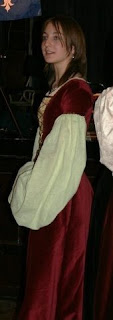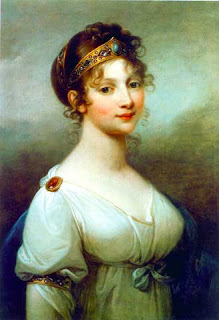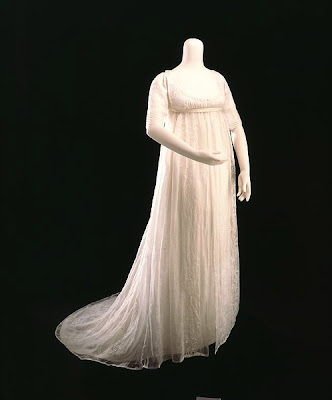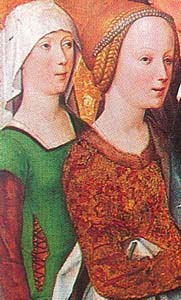Ok girls, i'm going to have to do to you what my archaeology lecturers did to me when they told me to forget everything i'd learnt about Indiana Jones and Time Team...
You know that pointy, cone-shaped hat you wore as a little girl to look like a medieval princess? Otherwise known as the 'conical' or 'steeple' hennin? Well here's the crush. It was a French fashion that didn't last very long. Probably for very obvious reasons, pure impracticality probably being the most likely. For some inexplicable reason, in the modern day it epitomises what girls think of when they think medieval princess... however they are extremely pretty!
You can find one of the best collections I've ever found of such image examples on Marie Chantal Cadieux's page: http://cadieux.mediumaevum.com/burgundian-hennin.html
Her whole website remains one of my most used web pages as a resource for costume help. It's excellent and very well thought out!
You may notice that many of these hennins do not have an entirely pointy top - they tend to be slightly rounded, or lopped off. Many women when historical re-enacting now (including myself) opt for something somewhat more practical. Like this:
Some hennins have a headband of black round the head and along the base of the hat, with a loop over the forehead, presumably to allow it to be pulled back on if it slips. I use one of black (cotton, not synthetic) velvet with my heavier hennins for it has friction that helps the hats fix.
One must note that hennins look a great deal better if worn at at least a forty-five degree angle on the head or parallel with the floor, rather than straight up. Search all images, and you will find that non of them are worn like tower turrets. In my own image of the hennin without a veil I feel that on this particular occasion it was not far enough back, though i have a suspicion that that had more to do with the misshapen nature of the frame underneath.
The best simple frame without fuss i've found yet is the felt fez. My one was not cheap, so i made sure it fitted comfortably before I splashed. It has so far survived many squashes in a travel bag. See below:
Before I'd even covered it, it was required for an event at Kelmarsh last year, so i simply hid it under a beaded silk veil Worked a treat, hardly anyone noticed it was just a fez:
Couched gold thread with black intersecting crosses.
I've covered the whole fabric with it.
Added glass seed beads in green, gold, black and pearly white. Pearls were a more authentic option than pearly white glass, but also a lot more expensive.
This has so far only been a quarter completed, so its a slow process - normally I can be found on the train sewing these tiny beads on. Some passengers think i must be so patient, others think i'm plain mad! :-) I'm not patient, i just want this posh hennin so badly! Not sure i'll finish it in time for my show this next weekend, but i'll get there soon... fingers crossed...






































